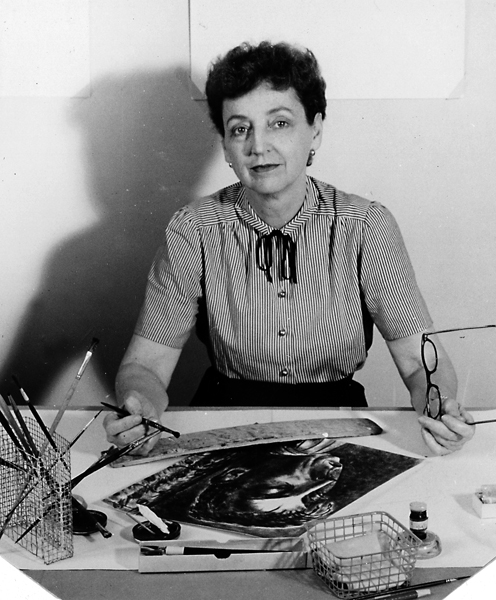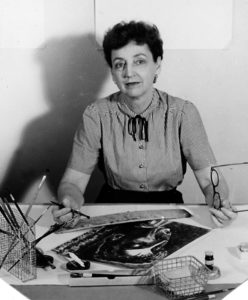Caroline Durieux
Artist Caroline Wogan Durieux served as the director of the Louisiana office of the Federal Art Project.

Courtesy of State Library of Louisiana
Caroline Durieux. Unidentified
Twentieth-century artist Caroline Wogan Durieux was a nationally known painter, lithographer, and social satirist. An important figure in New Orleans’s art world, particularly in the 1930 and 1940s, Durieux served as director of the Federal Art Project for Louisiana, administered by the Works Progress Administration (later renamed the Works Projects Administration). Durieux influenced future Louisiana artists not only with her art, but also by teaching at Newcomb College in New Orleans and at Louisiana State University in Baton Rouge. At the latter institution, she helped develop a new printmaking process utilizing radioactive ink.
Early Life
Born January 22, 1896, Caroline Wogan grew up on New Orleans’s Prieur Street in an extended Creole family that she credited for her satirical sensibility. Beginning in 1912, she studied art at Newcomb College under Ellsworth Woodward, a proponent of the fashionable Arts and Crafts movement. After winning a New Orleans Art Association scholarship, Durieux continued her studies at the Pennsylvania Academy of Fine Arts. In 1920, she married Pierre Durieux, an export merchant, with whom she would travel the Caribbean for the next fifteen years. Leaving Cuba for revolutionary Mexico in 1926, she gained the affection and the critical acclaim of painter and political activist Diego Rivera, who painted her portrait. There, too, critics assert, her art matured. She had always mocked the self-important and tilted at various windmills, and there were few better settings for this perspective than the tumult of revolutionary Mexico. Adopting lithography in Mexico, as one observer suggested, she “joined the ranks of social observers, satiric, witty, keen, and amusing in her observation of the foibles of humanity.”
Career in Louisiana
Upon Durieux’s return to New Orleans in 1936, Lyle Saxon, then director of the Louisiana Writers Project, hired her to help illustrate the New Orleans City Guide. In 1938, she joined the Newcomb faculty, with which she remained affiliated for the next five years. But almost immediately, in February 1939, she became the second of three state directors of the Louisiana office of the Federal Art Project (serving between Gideon Stanton and Angela Gregory). Ambitious and energetic, she initiated an aggressive plan to expand the project beyond its New Orleans confines. Her plans for classes in Baton Rouge, exhibitions in Reserve, Covington, and Boothville, and individual decorations for City Park, the Audubon Zoo, and the Magnolia Housing Project, however, soon met with sustained bureaucratic and local resistance.
In 1941, Durieux left New Orleans again, this time to work on behalf of the Museum of Modern Art in New York City. She accompanied a series of cultural exchanges and a showing of “democratic art” that the museum was sponsoring as it traveled throughout Latin America. During the Second World War, she accepted an appointment in the art department at Louisiana State University, where she remained until her retirement in 1963. While in Baton Rouge, she collaborated with the Department of Nuclear Science to pioneer an electron printmaking process using radioactive inks.
Significance
Throughout her life and beyond, critics hailed her artistic insight. “She tilts at a world she has always known, moved in, and rebelled against,” wrote one observer. “She belongs to the groups of social commentators, satiric, witty, keen, and amusing in her observation of the foibles of humanity,” agreed another. “She creates types and endows them with the truth of life and the enduring memorability of art.” Caroline Durieux died November 26, 1989, in Baton Rouge. Her work is included in the collections of the National Gallery of Art in Washington, D.C., the Museum of Modern Art in New York, and the Louisiana State University Museum of Art in Baton Rouge.
